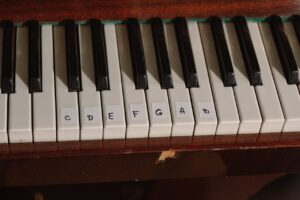The world of piano chords is vast and exciting. Essentially anytime you play more than two notes on the piano, you are playing a chord. We can use chords to express so much in music, from subtle textures to intense and emotional thunderstorms.
In this article, we will explore how we can use music theory to derive more intensity and expression from piano chords using chord inversions. Understanding how chord inversions work and learning to use them in your playing will open entire new sound worlds for you to explore.
Let’s get to it!
- Fall in love with the music - Learn your favorite songs, at a level suitable for you.
- Enjoy interactive piano lessons - Explore courses covering music theory, technique chords & more.
- Get real-time feedback - Skoove's feedback tells you what went well and what needs practice.

What are chord inversions?
Before we dive into chord inversions, let’s take a quick review of some basic piano chords. The most common type of chord that beginning pianists learn is called the triad. The triad is simply a three note chord.
In the triad, we have a root note, a middle note called the third, and a top note called the fifth. The root note is what names the chord. For example, a C major chord has the root note C. The middle note is what determines if the chord is a major or minor chord.
For example, if the root note is C and the middle note is E, then the chord will be C major:

If the root note is C and the middle note is E♭, then the chord will be C minor:

The top note essentially closes out the sound of the triad and adds weight and density to the harmony.
Triads with the root note as the lowest sounding pitch are called root position triads.
However, we can change the order of the notes in any chord. We call this chord inversion.
Different types of chord inversions
With triads, there are two types of chord inversions.
First inversion
The first type of chord inversion is called 1st inversion. In a 1st inversion triad, we shift the root note up one octave.
For example, in a C major chord, this changes the order of the tones from C – E – G to E – G – C. In the 1st inversion chord, the third is the lowest note.

Second inversion
The second type of chord inversion is called 2nd inversion. In a 2nd inversion triad, we shift the third up one octave.
Again, in a C major chord, this changes the order of the tones from E – G – C (1st inversion) to G – C – E (second inversion). In the 2nd inversion chord, the fifth is the lowest note.

Intervals of the inversions
These inversions also change the interval structure of the chord. In the root position C major chord, we find the interval structure of a major third followed by a minor third.
1st inversion of intervals
However, when we switch to the first inversion chord, we find a different interval structure. Between E – G is a minor third and between G – C is a perfect fourth.
Therefore the interval structure of a 1st inversion major triad is minor third followed by perfect fourth.

2nd inversion of intervals
When we switch to the 2nd inversion chord, we find again a different interval
structure. Between G – C is a perfect fourth and between C – E is a major third.
Therefore the interval structure of a 2nd inversion major triad is a perfect fourth followed by a major third.

Because of these different interval patterns, each of the chord inversions has a different feeling and weight to it. Explore using some of these inversions in your piano chord progressions and see how it changes the feeling of your music!
How to notate triad chord inversions
Learning how chord inversions are notated is essential to reading them accurately in music. Most frequently in pop music styles, chord inversions are written using slash notation.
Slash chords
Have you ever seen chord symbols like G/D or A/C♯ or E/B? These are examples of slash notation. Think of slash notation as a sort of fraction. For example, the chord symbol G/D literally means G over D, or G chord with D in the bass. Since D is the fifth of a G major triad, this means you should play a second inversion G major chord.

Likewise if you see a chord symbol like A/C♯ this literally means A over C♯, or an A chord with C♯ in the bass. Since C♯ is the third of an A major chord, this means you should play a first inversion A major chord.

Inversions beyond the triads
We can also have chord inversions beyond the triads. We can invert seventh chords. First let’s review the basics of seventh chords. Remember the formula for any seventh chord is some variation of 1 – 3 – 5 – 7.
For example, a C major 7 chord is spelled C – E – G – B. Since the bass note is also the root of the chord, this means that the chord in this sequence is in root position.
If you have never heard of seventh chords before, perhaps you should check out some best app for learning piano. With a wide range of topics from music theory to repertoire, Skoove offers music theory knowledge for every taste!

First inversion seventh chord
We can follow similar steps as we did with the triads to build inversions of the 7th chords. To build a 1st inversion C major 7th chord, simply move the root up one octave. Now the chord will be spelled E – G – B – C. This is the first inversion C major 7th chord.

Second inversion seventh chord
To build a 2nd inversion C major 7th chord, move the third up one octave. Now the chord will be spelled G – C – B – E. This is a 2nd inversion C major 7th chord.

Third inversion seventh chord
Since we have four tones in a seventh chord, that means we will have one additional inversion more than the triads. We call this inversion the third inversion.
To build the third inversion C major 7th chord, move the fifth up one octave. This means the chord will now be spelled G – B – C – E.

Intervals of seventh chord inversions
Like with the triads, inverting 7th chords changes the interval structure of the chord. In root position, the intervals of a major seventh chord are major third, minor third, major third.

1st inversion intervals of seventh chord
If we shift to the 1st inversion, the intervals are minor third (E – G), major third (G – B), minor second (B – C).

2nd inversion intervals of seventh chord
When we shift to 2nd inversion the intervals become major third (G – B), minor second (B – C), major third (C – E).

3rd inversion intervals of seventh chord
Finally, when we shift to the third inversion we find the interval pattern minor second (B – C), major third (C – E), minor third (E – G).

Pay attention!
Pay attention to how the minor second interval shifts through the inversions. This interval defines the sound of the inversion in a major seventh chord.
Likewise, we can invert all the different types of 7th chords. Dominant 7th, minor 7th, minor 7th flat 5th, and diminished 7th chords can all be inverted following the exact same steps.
Where are chord inversions used?
Chord inversions are found all over music and are used in many different settings and contexts. Chord inversions help to make chord progressions sound more smooth and connected.
If we only play root positions chords, each voice in the chord often has to make larger leaps. This type of playing sounds a little clunky and we can smoothen it out using some inversions.
View this post on Instagram
Root position chords
For example, here is a C major chord (C – E – G) to an F major chord (F – A – C) first with both chords played in root position:

See how each of the voices in the C major chord jumps a perfect fourth? This is a pretty large leap. If we use chord inversions, we can make it so each voice moves to the next in a more interesting way.
Root position to 2nd inversion
For example, let’s start again with the root position C major chord, then move to a 2nd inversion F major chord, maintaining C as the lowest note. It looks something like this:

See how in this example we keep C as the lowest note and then move the E – G up a second to F – A? We can then easily move back to the root position C major. This creates a more interesting melodic sound inside the chords.
1st inversion to root position
This time, let’s try a 1st inversion C major chord moving to a root position F major chord. We maintain the C at the top of the chord, but our lowest note changes from E to F.
This changing of the bass note up a half step forms a more solid resolution to the F major chord. We didn’t even change the chord progression, we just changed the chord inversion! Check it out notated:

7th chord progression using chord inversions
Let’s look at one more example using 7th chords. This time, we will start with a root position D minor 7th chord, then move to a 2nd inversion G7 chord, followed by a 1st inversion C major 7th chord.
This chord inversion pattern forms nice melodic lines in the top and middle voices of the chord progression. Check it out notated:

Conclusion
Learning how to use chord inversions will make your sound like a more interesting and experienced pianist. Chord inversion allows us to link chords together in a more natural way and helps to create more unique melody lines inside of chords. You can use chord inversions in just about any chord progression.
Skoove has many great lessons on chords and chord progressions. With repertoire ranging from classical hits to contemporary pop and everything in between, you are sure to find enough material to practice chord inversions for quite some time. Check out the 7 day free trial today and see how much fun you can have with Skoove!
Author of this blog post:

Eddie Bond is a multi-instrumentalist performer, composer, and music instructor currently based in Seattle, Washington USA. He has performed extensively in the US, Canada, Argentina, and China, released over 40 albums, and has over a decade experience working with music students of all ages and ability levels.
Published by Lydia Ogn from the Skoove team














